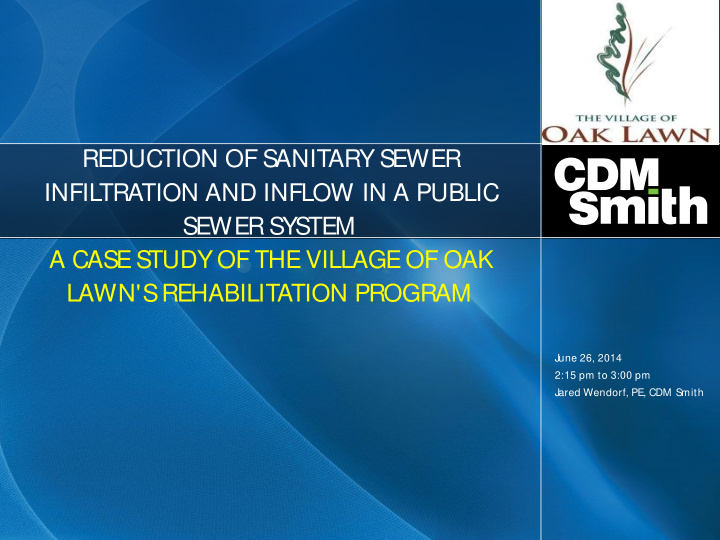



REDUCTION OF SANITARY SEWER INFIL TRATION AND INFLOW IN A PUBLIC SEWER SYSTEM A CASE STUDY OF THE VILLAGE OF OAK LAWN'S REHABILITATION PROGRAM June 26, 2014 2:15 pm to 3:00 pm Jared Wendorf, PE, CDM Smith
Repaired Fracture and Holes
C S W E A -2 0 1 4 C o lle ctio n S y ste m s C o n fe re n ce Acknowledgements • Larry Deetjen Oak Lawn Village Manager • Jack Gallagher Oak Lawn Village Engineer • Steve Barrett Oak Lawn Public Works Director • Bill Meyer Oak Lawn Sewers Crew Chief • Mandeera Wagle CDM Smith Project Manager • Doug Youngblood CDM Smith Technical Lead
Project Timeline Complete 2014 Rehab. Clean + Inspect Clean + Inspect Project Kickoff Develop 2013 Rehab Develop 2015 Rehab Begin Hydraulic Approach Approach Modeling 2010 2011 2012 2013 2014 2015 Complete Master Complete 2015 Complete 2013 Plan Rehab. Rehab. Clean + Inspect Clean + Inspect Develop 2016 Rehab Develop 2014 Rehab Approach Approach CSWEA-2014 Collection Systems Conference
Introduction to the Village of Oak Lawn Sewer S ystem • Oak Lawn incorporated in 1909 • Approx 55,000 Residents • 8.5 Sq M iles • Sanitary Sewers installed M id- Century • Separate Sewer Systems • Pipes are mostly clay CSWEA-2014 Collection Systems Conference
Hydraulic M odeling and Flow M onitoring Objective – Create a Sanitary Sewer M aster Plan — A Roadmap • – Comprehensive model of the entire system – Rainfall and flow data measured and integrated – Three Hydrograph Method CSWEA-2014 Collection Systems Conference
Hydraulic M odeling and Flow M onitoring • Identify potential problem areas • Prioritize use of limited funds CSWEA-2014 Collection Systems Conference
Cleaning and T elevised Inspections • Development of 2012 Program • Use M aster Plan to identify two areas at most risk – Clean and Inspect approximately 16,600 lf of pipe in projected future problem areas – Inspect approx 100 manholes – Time of Project – 8 working days – Average 2,075 ft / day • Next Steps – Analyze inspections and develop rehabilitation plan CSWEA-2014 Collection Systems Conference
Cleaning of Sanitary Sewers and T elevised Inspections — Prioritization of Rehab • High Priority – Risk of collapse / sinkholes – M ajor structural damage – M ajor infiltration potential • M edium Priority – Some infiltration potential – Structural damage likely to degrade to major damage • Low Priority – M ineral deposits – Fine roots – Hairline cracks, small sags CSWEA-2014 Collection Systems Conference
Pipe fractures In 10962
Pipe fractures In 10961
Offset joints and Intruding taps at 7288
Fractures at 7374
Hammer Tap – Infiltration Around Edges
Intruding break-in tap at 7249
Develop Plan for 2013 Rehabilitation • Select rehabilitation methods to repair approx 10,000 ft of pipe – Options for pipe repair: • pipe replacement • slip lining • CIPP • Spot repairs • Short liners • Break in tap repairs (LCR) • Lateral Grouting CSWEA-2014 Collection Systems Conference
Develop Plan for 2013 Rehabilitation • Select rehabilitation methods to rehab approx 50 manholes – Options for manhole repair: • Raising M anhole Lids • Chimney Seals • Chemical Grouting • Cementitious Resurfacing • Concrete Surfacing at M anhole/ Liner Interface • Pipe Seals CSWEA-2014 Collection Systems Conference
Water Source or Steam Source Refrigerated Truck
CIPP rehabilitation
CIPP rehabilitation
CIPP rehabilitation
Execute 2013 Rehabilitation • Repair approx 10,000 ft of pipe and Rehab approx 50 manholes based on 2012 inspections results • Clean and Inspect 10,000 additional ft of pipe and inspect approx 100 additional manholes (two additional sewersheds) • Provide unit cost rates that the Owner can use to authorize rehab of newly inspected pipes and manholes • Repair newly inspected pipes and manholes CSWEA-2014 Collection Systems Conference
2013 Rehabilitation Summary Manholes CIPP Lining in Additional Area Rehabilitated 2013 Rehab Area #1 5,389 of 6,022 lf two spot 29 of 32 (91%) (89%) repairs Area #2 4,488 of 10,255 lf 1 short liner, 1 37 of 60 (62%) (44%) LCR Area #3 5,182 of 12,303 lf 1 short liner, 1 42 of 71 (59%) (42%) LCR Area #4 2,985 of 6,258 lf 18 of 40 (45%) (48%) CSWEA-2014 Collection Systems Conference
Fractures and Hole in Pipe
Repaired Fracture and Holes
Fractures – Imminent Risk of Collapse
Repaired Fractures
Hole in Pipe Active Infiltration
Location of Repaired Hole in Pipe Location of Infiltration Defect
Fractures – Pipe Approaching Collapse
Repaired Fractures
Cast in Place Pipe Structural Integrity CSWEA-2014 Collection Systems Conference
Analysis of 2013 Rehabilitation • Identify common sources of problems CSWEA-2014 Collection Systems Conference
2014 Rehabilitation Work •
Creating a Sustainable Funding Source • 2012-2013 work was funded by Build America Bonds • The Village recognized the need for a sustainable funding source • Benchmarking against similar communities showed that a reasonable sewer rate increase was warranted • The funds from this increase are accounted for separately in a fund allowing 1-2% of the system to be rehabilitated annually. • Spend approx $1M per year CSWEA-2014 Collection Systems Conference
Summary • The Village of Oak Lawn has successfully initiated a comprehensive annual sanitary sewer rehabilitation program that is effective and sustainable. • The efficiency of the program increases with each year by building upon specifications and improvements of prior years. • T o date, Oak Lawn has rehabilitated more than 20,000 linear feet of pipe and 150 manholes, and is currently preparing for the next phase of rehab starting in Summer 2014.
Lessons Learned • Emphasize the importance of the contractor walking the site • Hold a mandatory Pre-bid. • Communicate early and often with homeowners • Use LCR in combination with short liners • Have a protocol set up for resident issues
Contact Information Jared Wendorf, PE CDM Smith Chicago wendorfjw@cdmsmith.com
Recommend
More recommend